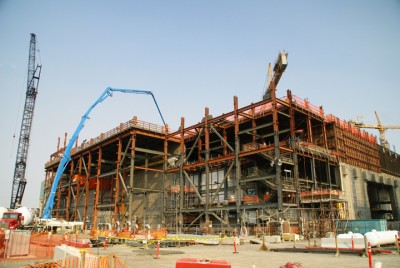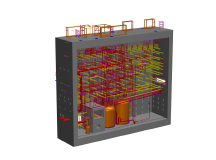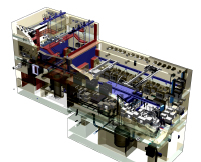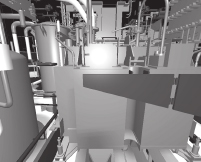High-Level Waste (HLW) Vitrification Facility
 The Hanford Waste Treatment and Immobilization Plant, once fully operational, will include a High-Level Waste Facility.
The Hanford Waste Treatment and Immobilization Plant, once fully operational, will include a High-Level Waste Facility.
In the HLW Facility, high-level waste will be mixed with glass-forming materials in two 90-ton melters and heated to 2,100 degrees Fahrenheit. The mixture will then be poured into stainless steel canisters that are approximately 2 feet in diameter, 14.5 feet tall and weigh more than 4 tons. When fully operational, the HLW Facility will produce an annual average of 480 canisters.
The full canisters will be temporarily stored at a canister storage facility in Hanford’s 200 Area.
When complete, the HLW Facility will be 440 feet long and 275 feet wide, approximately the size of three football fields, and 95 feet, or six stories, high.
A Closer Look Inside the High-Level Waste Vitrification Facility
THE WET CELL
 The wet cell rests inside a facility black-cell area, behind steel-laced, high-strength concrete walls, and is inaccessible to workers. Once inside the High-Level Waste Facility, pretreated waste is transferred through shielded pipes into a series of melter preparation and feed vessels before reaching the melters.
The wet cell rests inside a facility black-cell area, behind steel-laced, high-strength concrete walls, and is inaccessible to workers. Once inside the High-Level Waste Facility, pretreated waste is transferred through shielded pipes into a series of melter preparation and feed vessels before reaching the melters.
THE MELTER CELL
 The facility contains two identical, remotely operated melter caves. Due to potential high levels of radioactivity in the caves, all operations and maintenance activities are performed using remote-handled large overhead cranes and manipulators. Each cave contains a series of complex utilities to support two high-level waste vitrification melters. The melters are supported by offgas cleaning systems that include a submerged bed scrubber vessel and two high-efficiency mist eliminators.
The facility contains two identical, remotely operated melter caves. Due to potential high levels of radioactivity in the caves, all operations and maintenance activities are performed using remote-handled large overhead cranes and manipulators. Each cave contains a series of complex utilities to support two high-level waste vitrification melters. The melters are supported by offgas cleaning systems that include a submerged bed scrubber vessel and two high-efficiency mist eliminators.
PRODUCTION AND OPERATIONS
 Two identical 90-ton melters, each 14 feet by 14 feet and 11 feet high, will produce a sturdy glass product that consists of about 30 percent waste and 70 percent additives. The facility will annually produce an average of 480 canisters.
Two identical 90-ton melters, each 14 feet by 14 feet and 11 feet high, will produce a sturdy glass product that consists of about 30 percent waste and 70 percent additives. The facility will annually produce an average of 480 canisters.





